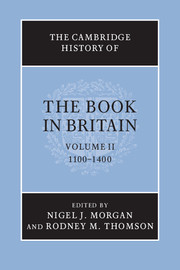Book contents
- Frontmatter
- Preface
- The roles of books
- Book production
- Readership, libraries, texts and contexts
- 9 Library catalogues and indexes
- 10 University and monastic texts
- 11 Law
- 12 Books for the liturgy and private prayer
- 13 Compilations for preaching and Lollard literature
- 14 Spiritual writings and religious instruction
- 15 Vernacular literature and its readership
- 16 History and history books
- 17 Archive books
- 18 Scientific and medical writings
- 19 Music
- 20 Illustration and ornament
- List of abbreviations
- Bibliography
- Photo credits
- General index
- Index of manuscripts
- Plates 1
- Plates 2
- References
14 - Spiritual writings and religious instruction
from Readership, libraries, texts and contexts
Published online by Cambridge University Press: 28 November 2008
- Frontmatter
- Preface
- The roles of books
- Book production
- Readership, libraries, texts and contexts
- 9 Library catalogues and indexes
- 10 University and monastic texts
- 11 Law
- 12 Books for the liturgy and private prayer
- 13 Compilations for preaching and Lollard literature
- 14 Spiritual writings and religious instruction
- 15 Vernacular literature and its readership
- 16 History and history books
- 17 Archive books
- 18 Scientific and medical writings
- 19 Music
- 20 Illustration and ornament
- List of abbreviations
- Bibliography
- Photo credits
- General index
- Index of manuscripts
- Plates 1
- Plates 2
- References
Summary
As soon as a would-be writer picked up the pen in this period, he (or just occasionally she) had to make a far-reaching decision: whether to write in English, Anglo-Norman or Latin. The answer would emerge from the intersection of the text’s genre and of the gender, social and religious status of both the writer and the planned audience. Until around 1300, Latin texts would be read almost exclusively by male clerics and vernacular texts by the laity of both sexes and by women religious, though Anglo-Norman texts might be aimed at a slightly higher social class than those in Middle English. But Latin texts might also function as scripts for oral transmission by priests to their parishioners in English, while male clerics did read, and own, texts in French and English as well as Latin. In the fourteenth century, however, ‘a new, more pragmatic view of the appropriate language’ developed. The choice of French or English became ‘fundamentally a political decision – whether to address the rulers or the ruled. The writers themselves, nearly always clerics, are those with education who are for that reason part of the establishment of power. In composing in English they are addressing the unlearned, sometimes to edify, sometimes to entertain, always to instruct.’
- Type
- Chapter
- Information
- The Cambridge History of the Book in Britain , pp. 340 - 366Publisher: Cambridge University PressPrint publication year: 2008
References
- 1
- Cited by



